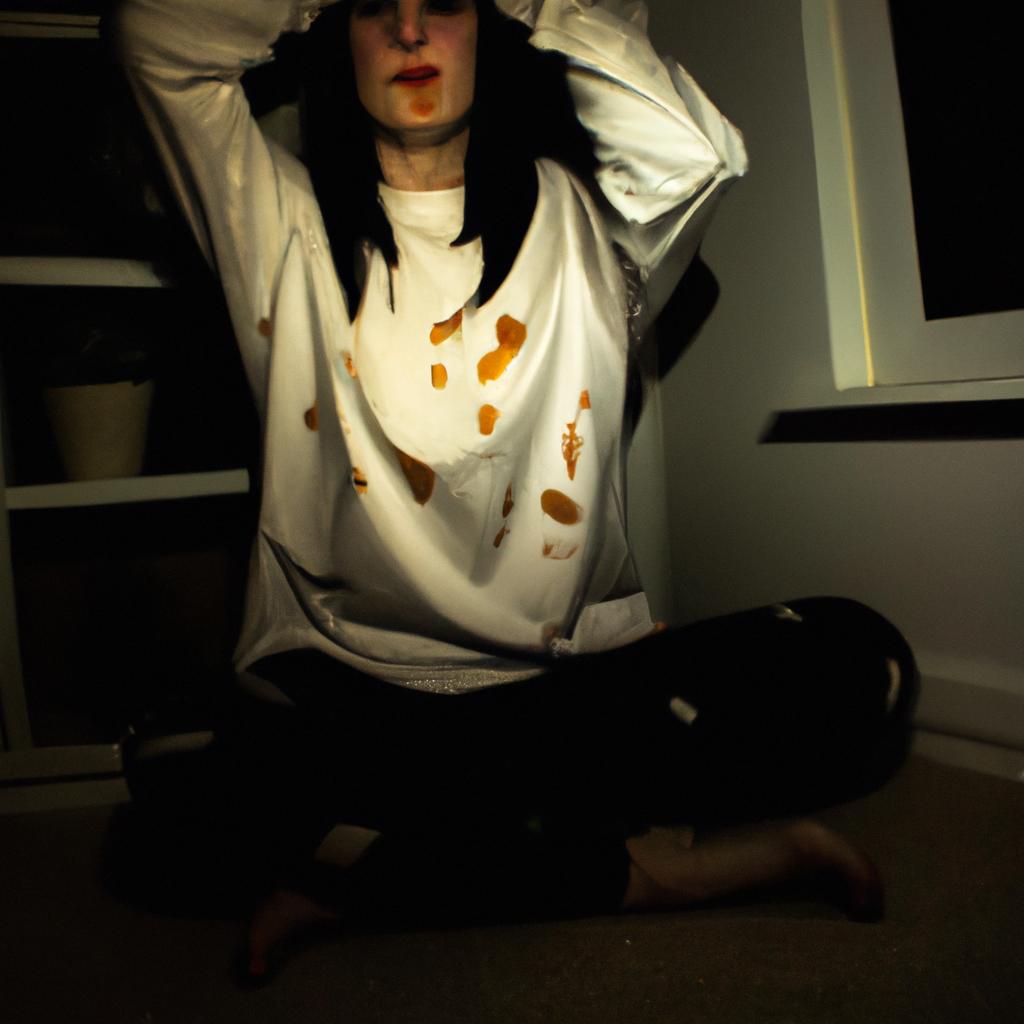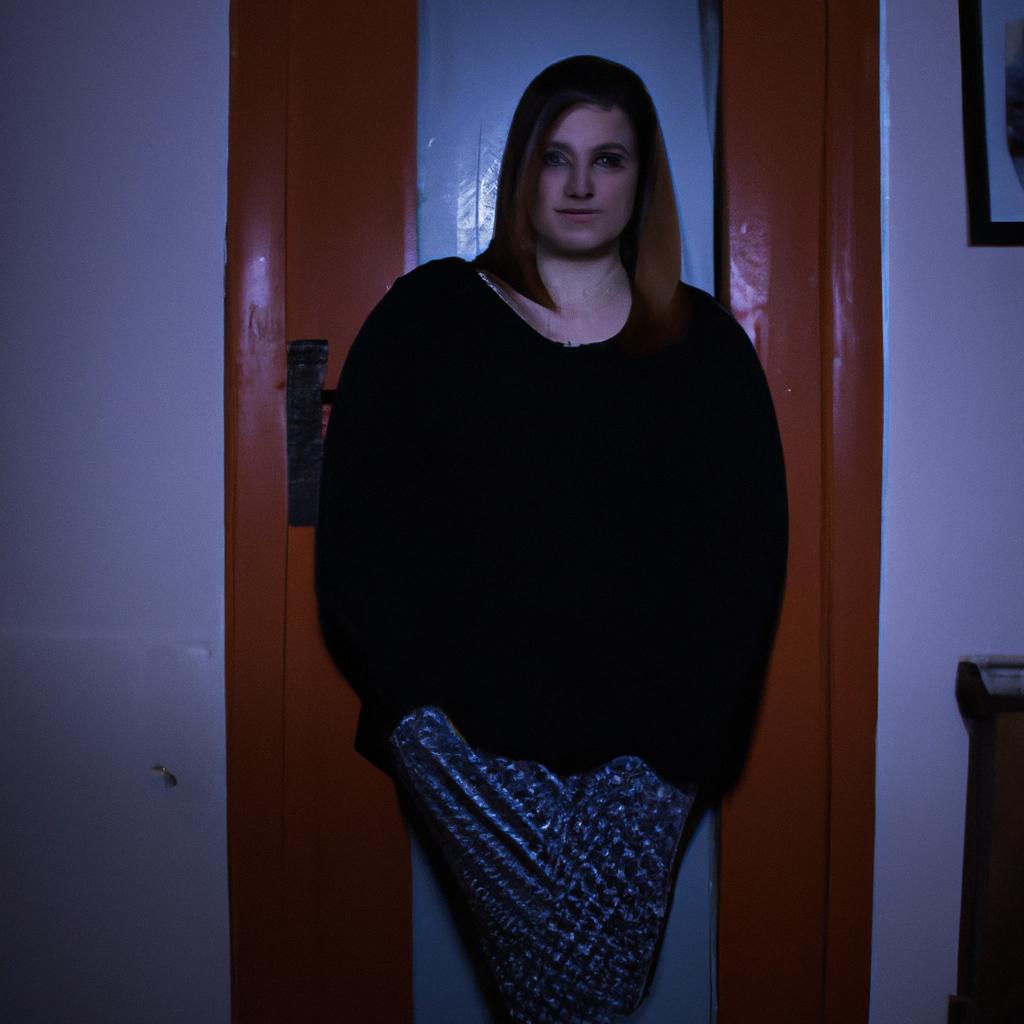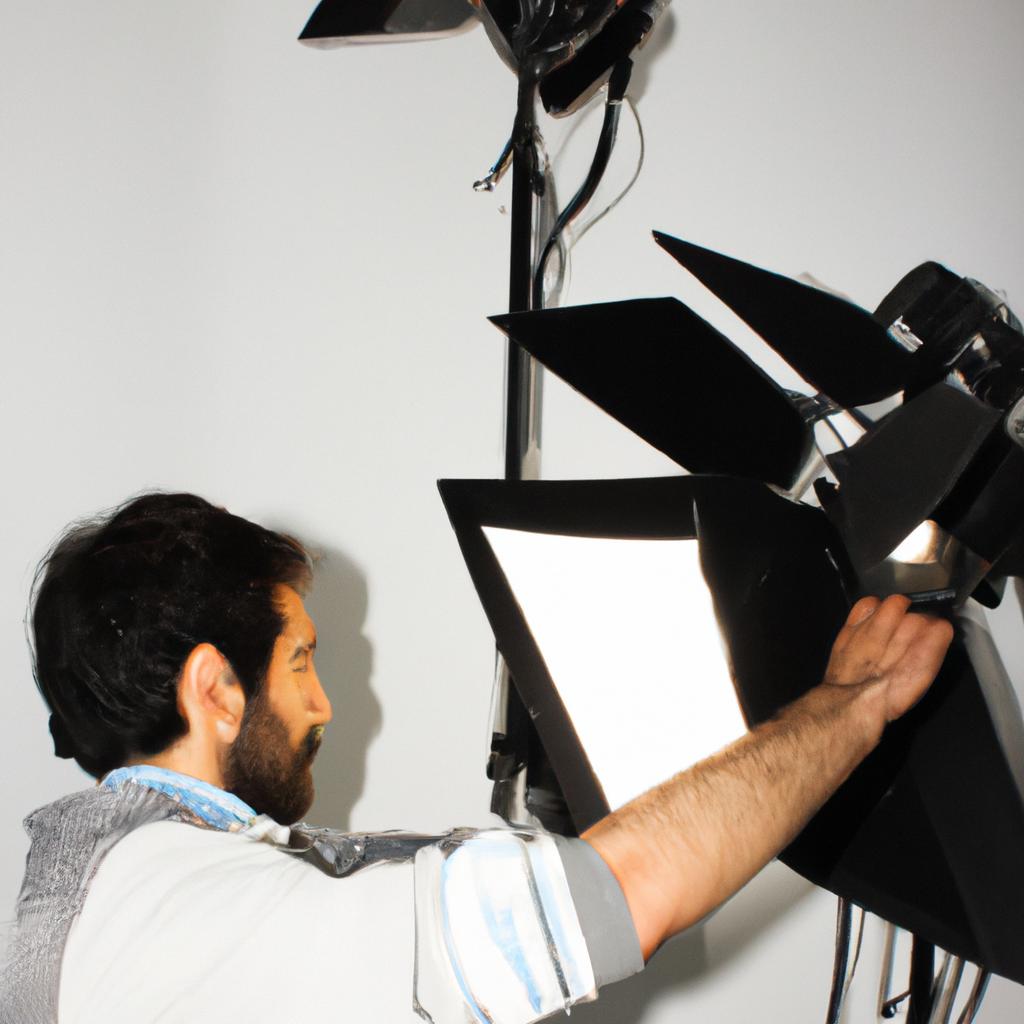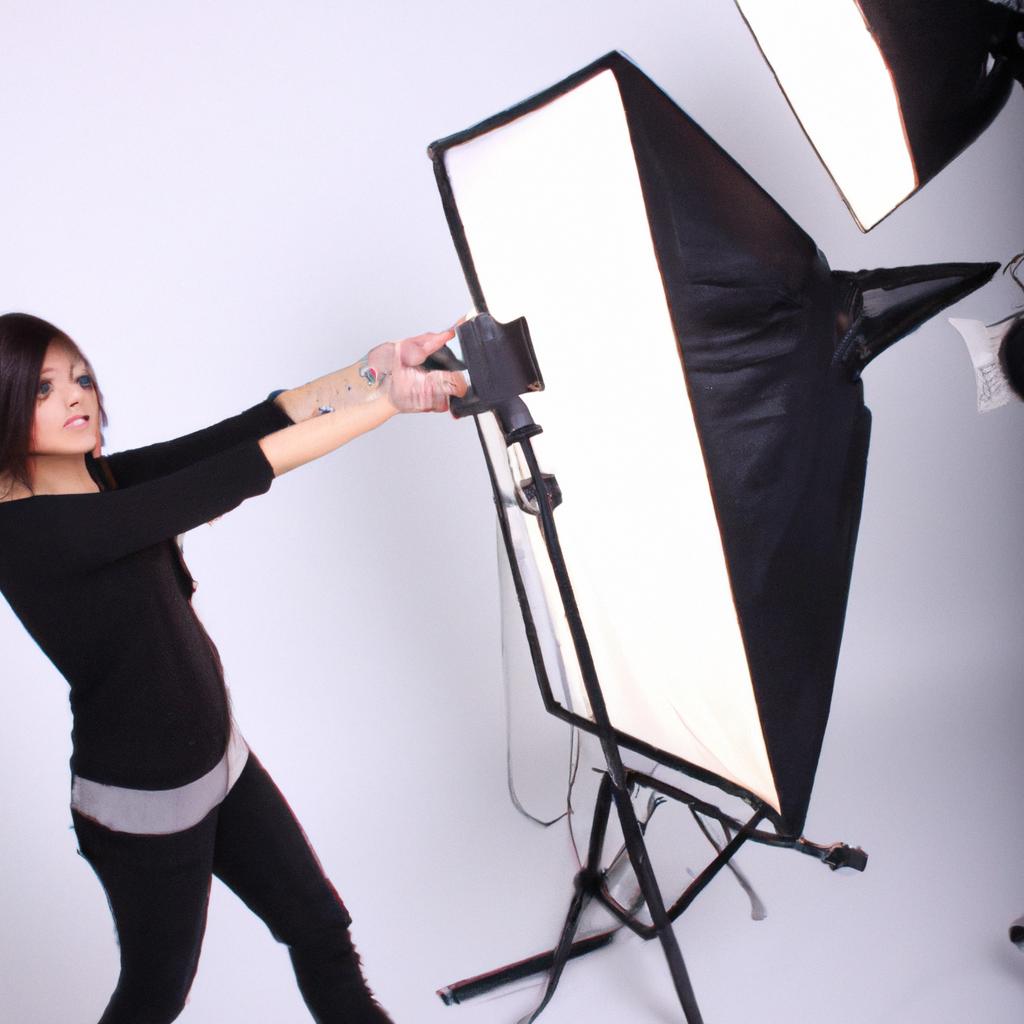Boudoir photography, a genre that celebrates the sensuality and intimacy of its subjects, requires meticulous attention to detail in order to capture the desired ambiance. One crucial aspect of boudoir photography is mastering lighting techniques, as it plays an indispensable role in setting the mood and highlighting the subject’s features effectively. Consider, for instance, a hypothetical scenario where a photographer aims to create a sultry atmosphere using soft lighting and gentle shadows. By employing appropriate lighting techniques, such as utilizing diffusers or reflectors strategically, the photographer can enhance the overall appeal of the images while maintaining a sense of sophistication.
In this article, we will delve into composition tips specifically tailored for boudoir photographers seeking to elevate their skills in manipulating light effectively. With careful consideration given to elements such as natural and artificial light sources, positioning of lights, and selection of modifiers like umbrellas or softboxes, photographers can craft visually captivating compositions that emphasize their subjects’ innate allure. Through exploration of various lighting setups and their potential impact on the final image outcome, this article aims to provide aspiring boudoir photographers with valuable insights on how they can master lighting techniques to achieve stunning results.
Understanding the Importance of Shadows
One crucial aspect of boudoir photography is mastering lighting techniques to create captivating and alluring images. When it comes to creating a visually stunning composition, understanding the importance of shadows plays a pivotal role. Shadows not only add depth and dimension to an image but also evoke emotions by accentuating certain features or concealing others.
To illustrate this point, let’s consider a hypothetical scenario where a boudoir photographer aims to highlight the sensuality and elegance of their subject. By strategically placing a light source at a low angle, casting soft shadows across the body, they can create a sense of mystery and allure. These shadows can emphasize curves, contours, and textures while adding an air of sensuality that draws viewers into the photograph.
In order to fully comprehend the impact of shadows in boudoir photography, we need to explore its emotional significance. Here are four key reasons why shadows are vital in creating evocative imagery:
- Enhancing mood: Shadows have the power to set the tone and atmosphere for an image. Whether it’s mysterious and seductive or intimate and romantic, manipulating shadows allows photographers to convey specific emotions effectively.
- Concealing imperfections: Shadows can be utilized as a tool for discretion by selectively obscuring certain parts of the body or minimizing perceived flaws. This technique helps clients feel more comfortable during their session while maintaining an elegant aesthetic.
- Accentuating shape: Shadows play with perception, allowing photographers to enhance body shapes through strategic placement. Subtle shadowing on curves or muscles can make them appear more defined and sculpted.
- Adding depth: Shadows provide visual depth within an image, transforming two-dimensional photographs into multidimensional works of art. They guide the viewer’s eye through various planes, making the composition more engaging.
By understanding these emotional associations connected with shadow usage in boudoir photography, photographers can craft compelling compositions that resonate with viewers on a deeper level.
Transitioning seamlessly to the subsequent section, we will explore another essential aspect of lighting techniques: utilizing natural light to create a soft, romantic ambiance.
Utilizing Natural Light to Create a Soft, Romantic Ambiance
In boudoir photography, understanding the importance of shadows is crucial as it can greatly impact the overall mood and aesthetic of the images. By skillfully manipulating shadow patterns, photographers can create depth, accentuate curves, and evoke a sense of sensuality. Let’s consider an example to illustrate this concept further.
Imagine a boudoir photoshoot where the subject is positioned near a window with soft natural light streaming through partly closed curtains. As the sunlight filters through the fabric, delicate shadows are cast on the subject’s body, highlighting her curves and creating an alluring atmosphere. The interplay between light and shadow adds depth and dimension to the image, enhancing its visual appeal.
To effectively utilize shadows in your boudoir photography, here are some key considerations:
- Directionality: Experiment with different angles and positions of light sources to control how shadows fall on your subject. This will allow you to emphasize specific features or create interesting shapes.
- Intensity: Adjusting the intensity of light can alter the strength of shadows. Play around with dimming or diffusing lights to achieve softer or more dramatic effects.
- Contrast: Utilize contrasting elements like dark fabrics against lighter skin tones or vice versa to enhance shadow play and draw attention to certain areas.
- Texture: Shadows have the ability to emphasize texture within an image. Incorporate textured props or backgrounds that interact with lighting conditions for added visual interest.
By skillfully employing these techniques, you can master the art of using shadows in boudoir photography to capture captivating images that exude sensuality and allure.
Next section H2:’Utilizing Natural Light to Create a Soft, Romantic Ambiance’
Using Reflectors to Fill in Shadows and Enhance Highlights
In boudoir photography, the skillful use of lighting techniques is paramount to creating captivating images that enhance the subject’s features while evoking a sensual ambiance. Building upon our previous discussion on natural light and reflectors, this section will delve into the importance of utilizing off-camera flash to add depth and dimension to your boudoir compositions.
Example Scenario:
Imagine a scenario where you are photographing a client in an intimate setting, such as a bedroom adorned with soft, flowing fabrics and delicate candlelight. By strategically placing an off-camera flash at a 45-degree angle from the subject and diffusing its output through a softbox or umbrella, you can create dramatic shadows and highlights that accentuate the curves of their body. This technique adds volume and three-dimensionality to the image, elevating it beyond mere snapshots.
Enhancing Depth and Dimension:
To achieve visually striking results when using off-camera flash for boudoir photography:
-
Placement: Experiment with different positions for your off-camera flash to determine the most flattering angles for your subject. Consider positioning it slightly above eye level, casting downward shadows that highlight facial features while adding depth.
-
Diffusion: Attach modifiers like softboxes or umbrellas to soften harsh flashes and create more pleasing, even illumination across the scene. Softening light helps minimize imperfections while preserving details in both skin tones and textures.
-
Power Control: Adjusting flash power allows you to strike a balance between illuminating your subject adequately without overpowering them or washing out details. Start by experimenting with lower power settings before gradually increasing if necessary.
-
Balancing Ambient Light: To maintain visual harmony within your composition, ensure proper synchronization between ambient light sources (such as candles or lamps) and artificial lights (e.g., off-camera flash). Strive for coherence by adjusting exposure settings accordingly.
By skillfully incorporating off-camera flash techniques, you can transform your boudoir photography into visually captivating narratives that celebrate the beauty and sensuality of your subjects.
Having explored the art of enhancing depth and dimension through off-camera flash, let us now turn our attention to another vital aspect of mastering lighting in boudoir photography: experimenting with different light sources to set the mood.
Experimenting with Different Light Sources to Set the Mood
Section Transition: Building on the knowledge of using reflectors, boudoir photographers can further enhance their lighting techniques by experimenting with different light sources to set the mood. By understanding how various lighting options can dramatically impact the overall composition of a boudoir photograph, photographers can create captivating and emotionally resonant images.
Case Study:
For instance, imagine a scenario where a photographer is capturing an intimate portrait in a dimly lit bedroom setting. The use of soft candlelight as the primary light source creates a warm and romantic ambiance, emphasizing the sensuality and intimacy of the moment. This example showcases how selecting specific light sources can evoke certain emotions and contribute to the desired mood in boudoir photography.
- Consider using natural light streaming through curtains or blinds for a soft and ethereal effect.
- Experiment with colored gels placed over artificial lights to add drama or accentuate particular elements.
- Use fairy lights or string lights to create a magical and dreamy atmosphere.
- Incorporate directional lighting from lamps or spotlights to highlight specific features or areas of interest.
| Lighting Option | Mood Created |
|---|---|
| Soft Candlelight | Romantic |
| Natural Daylight | Ethereal |
| Colored Gels | Dramatic |
| Fairy Lights | Dreamy |
Incorporating these different light sources into boudoir photography allows for endless creative possibilities and enables photographers to customize each session based on their clients’ preferences and desired outcomes. By carefully selecting appropriate lighting options, photographers can capture compelling images that convey emotion, tell stories, and leave lasting impressions on viewers.
Moving beyond exploring different light sources, another effective technique for enhancing boudoir photographs involves creating depth and dimension with backlighting.
Creating Depth and Dimension with Backlighting
Building on the importance of experimenting with different light sources, photographers can take their boudoir photography to the next level by mastering techniques that create depth and dimension through backlighting. By strategically placing a light source behind the subject, photographers can achieve captivating effects that enhance the overall mood and composition of their images.
Backlighting refers to positioning a light source behind the subject in order to illuminate them from behind. This technique not only adds depth and dimension but also creates a beautiful halo effect around the subject. For instance, imagine capturing an intimate boudoir portrait where soft sunlight filters through sheer curtains, casting a gentle glow on the model’s silhouette. This interplay between light and shadow creates an enchanting atmosphere that evokes feelings of sensuality and mystery.
To make the most of backlighting in boudoir photography, consider these key aspects:
- Light placement: Experiment with different angles for optimal results. Placing the light slightly off-center or at a low angle can emphasize contours and highlight curves in an elegant way.
- Light intensity: Adjusting the brightness of the backlight allows for various creative possibilities. A subtle glow can add a touch of romance, while a stronger backlight can create more dramatic silhouettes.
- Controlling flare: Be mindful of lens flare when shooting into direct light sources. Consider using lens hoods or adjusting your camera angle to prevent excessive flaring that may distract from your intended composition.
- Balancing ambient lighting: Take into account any available natural or artificial lighting in your environment. Harmoniously blending both front lighting (from other sources) with backlighting can result in beautifully balanced images.
| Key Aspects | Tips |
|---|---|
| Light Placement | Experiment with angles |
| Place off-center or at low angles | |
| Light Intensity | Adjust brightness for desired effect |
| Subtle glow for romance, stronger for drama | |
| Controlling Flare | Use lens hoods or adjust camera angle |
| Balancing Ambient Lighting | Blend front and backlighting |
By mastering the art of controlling and manipulating light in boudoir photography, photographers can achieve captivating results. The interplay between different light sources creates a dynamic composition that enhances the overall mood and atmosphere of the images.
Building on the importance of creating depth and dimension through backlighting, let’s now explore how to master the art of controlling and manipulating light in boudoir photography.
Mastering the Art of Controlling and Manipulating Light
Building upon the concept of creating depth and dimension with backlighting, let us now delve into the art of controlling and manipulating light in boudoir photography. By mastering various lighting techniques, photographers can elevate their compositions to new heights, enhancing mood, highlighting key features, and capturing the essence of their subjects.
To illustrate the importance of light manipulation, consider a hypothetical scenario where a photographer wishes to emphasize the sensuality and allure of a subject’s figure. The use of soft, diffused lighting can help create an intimate atmosphere while gently sculpting the body’s contours. This technique allows for subtle shadows that accentuate curves without overpowering or distorting them. By understanding how different light sources interact with surfaces and paying attention to placement and angles, photographers can achieve stunning results that evoke emotion within viewers.
In order to effectively control and manipulate light in boudoir photography, here are some essential tips:
- Utilize reflectors: Reflectors are versatile tools that bounce light onto specific areas, helping to fill in shadows or redirect illumination as desired.
- Experiment with gels: Colored gels placed over lights allow for creative expression by adding hues or altering the overall color temperature of an image.
- Employ window lighting: Natural light streaming through windows provides a soft and flattering quality that complements many boudoir settings.
- Explore artificial lighting setups: From simple one-light setups to more complex arrangements involving multiple strobes or continuous lights, experimenting with artificial lighting enables photographers to achieve precise control over every aspect of illumination.
Photographers who master these techniques will be able to:
- Create captivating images that exude confidence and elegance.
- Evoke emotions through expertly controlled play on highlights and shadows.
- Highlight unique features while maintaining a sense of intimacy.
- Elevate storytelling by using light as a narrative tool.
| Lighting Technique | Description |
|---|---|
| Rembrandt lighting | Utilizes a single light source positioned at a 45-degree angle to create dramatic shadows and highlights, often forming a triangle of light on the subject’s cheek. |
| Split lighting | Involves placing the light source perpendicular to the subject, resulting in one side being brightly lit while the other remains in shadow. This technique is ideal for creating contrast and emphasizing facial features. |
| Butterfly lighting | Achieved by positioning the main light directly above the subject’s face, casting an even illumination that softens any imperfections and creates a subtle butterfly-shaped shadow under the nose. |
| Rim lighting | Uses backlighting to outline or silhouette the subject against a darker background, adding depth and separation from the surroundings. |
Incorporating these techniques into boudoir photography allows photographers to unleash their creativity, crafting visually striking images that truly capture the essence of their subjects.
Remember, mastering the art of controlling and manipulating light requires practice, experimentation, and attention to detail. By understanding how different lighting setups can evoke specific moods and enhance composition, photographers can elevate their work and create stunning visual narratives that resonate with viewers.
 LW Larsen Photo
LW Larsen Photo



